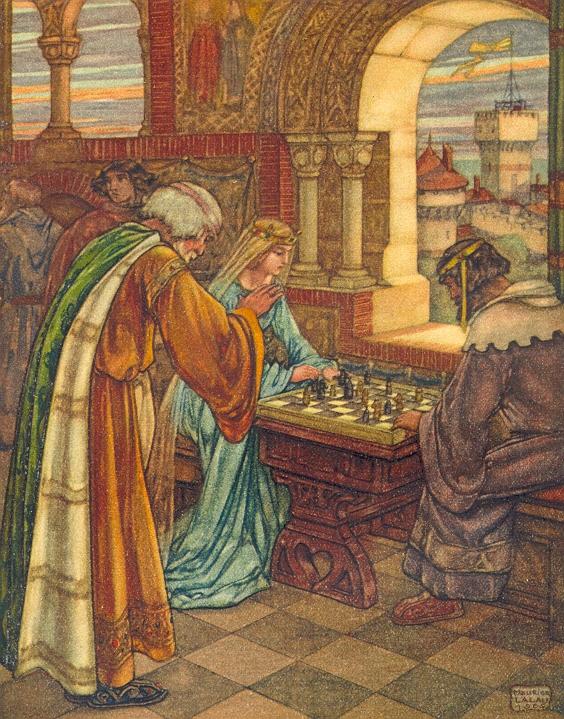
Edward Winter

See C.N. 2943 in ‘Genius’.
We have been reviewing old technical chess terms which have fallen out of use. From page 7 of George Walker’s The Art of Chess-Play (London, 1846):
‘Check divergent. This expression is occasionally used to signify your giving a check to the king, and attacking another piece on the same move. Thus, when the knight forks king and queen, it may be termed giving divergent check to king and queen.’
This recalls a passage from The Compleat Gamester by Charles Cotton (London, 1674):
‘There is an ingenious way of taking a great man for a Pawn; when you espy two great Men of your Adversaries standing in one and the same Rank, and but one House between them, then prepare a Guard (if you have it not ready to your hand) for a Pawn, which bring up to the Rank next to them in the middle or front of both of them, and without doubt if he save the one your Pawn will take the other; this way of taking is called a Fork or Dilemma.’
In addition to ‘dilemma’, the word ‘house’ above (in the sense of a square) may be noted. Such usage was still common a century later, as is shown by the chess entry in the first (1771) edition of the Encyclopaedia Britannica (see C.N. 1887 on pages 252-253 of Chess Explorations).
An instalment of ‘An English chess glossary’ on page 297 of the Chess Monthly, October 1858 had the term ‘enigma’, which was defined as follows:
‘A termination of a game; an end-position, not represented upon a diagram, but written out.’
Other old terms long since gone include ‘chess brilliants’, ‘chess nuts’ and ‘chess parties’.
(3341)
Airplane checkmate: See C.N. 5087.
Circumrotatory chess: ‘... much practice in matches of this kind has made him very proficient in circumrotatory chess.’ City of London Chess Magazine, June 1875, page 130.
Conversation game: ‘There will shortly commence a conversation game between some New York players and members of the Williamsburgh Club.’ The Albion, 19 March 1870, page ?
Correspondental: ‘To prevent unlimitedly tedious prolongation in a correspondental game between two clubs, there is generally a fixed time allowed for each move ...’ Page 33 of A Popular Introduction to the Study and Practice of Chess (London, 1851) written by S.S. Boden but published anonymously.
Counter-check: ‘Is the word counter-check a legitimate Chess-term? If so, what writer on the game has used it?’ Chess Monthly, May 1861, page 137.
Dilemma: Obsolete term for fork. See C.N. 3341 above.
Enigma: ‘A termination of a game; an end-position, not represented upon a diagram, but written out.’ Chess Monthly, October 1858, page 297.
Fidation, to fidate: See C.N. 12055.
Flash-light tournament: ‘A flash-light tournament was held in Glasgow last week, and was a great success. For the first six moves five seconds were allowed, 15 seconds for the following six, and half-a-minute for the remaining moves in each game.’ Liverpool Mercury, 2 May 1896, page 7. See C.N. 11621.
Gamekin, gamikin: see C.N. 8881.
Losish: ‘It is usually no harder to win a drawish game than a losish game, and the latter has the disadvantage that you may lose.’ Cecil Purdy on page 16 of the Australasian Chess Review, 25 January 1939.
Masque game: ‘It has also been announced that the last-mentioned Club will give a masque game upon a ball-room floor ...’ The Albion, 19 March 1870, page ?.
Pawnence: ‘The board has been rent in two. The king-side belongs to White; the queen-side is Black’s. And Black is ready to collect pawnence! The isolated pawn is doomed.’ Chess Review, April 1950, page 120. See C.N. 8561.
Pedaneous chess: ‘We believe this was the first occasion of his undertaking pedaneous chess ...’ City of London Chess Magazine, August 1875, page 196.
Problemistically: ‘Although he has not been very active problemistically since the Westminster Gazette column disappeared the problem world is poorer for his loss.’ BCM, January 1933, page 44 (obituary of J. Schumer).
Re-diagram: ‘Below we correctly re-diagram the entry that won first prize.’ Chess World, 1 January 1947, page 23.
Sacs-back: ‘For the next half-dozen moves a cardinal consideration is the efficacy of possible “sacs-back” on d5.’ Playing to Win by J. Plaskett (London, 1988), page 66.
Simultanee: ‘The simultanee should keep an eye on the rate of progress of the single player ...’ BCM, April 1943, page 74.
Skalitzka system: See C.N. 9140.
Snowball game: A term used on page 196 of the July-August 1919 American Chess Bulletin and on page 212 of the April 1920 Chess Amateur. See C.N. 8639.
Ticket tournament: See C.N.s 5105 and 5133.
Wopatzerschach: See C.N. 12070.
Zugzwanger: ‘A typical “Zugzwanger”.’ How to Win in the Middle Game of Chess by I.A. Horowitz (New York, 1955), page 108.
Zwischenfehler: ‘For a move such as Black’s 25th we offer the term Zwischenfehler.’ E. Winter, C.N. 2784, 20 October 2002. (See page 61 of A Chess Omnibus and Chess Jottings.)
Acknowledgement: Jerry Spinrad (Nashville, TN, USA): conversation game and masque game – see C.N. 4226; flash-light tournament – see C.N. 11621.
Concerning divergent check and check divergent, see also C.N. 4936.
C.N. 9247 gave the definitions of a number of terms proposed in the glossary on pages 154-156 of The Most Valuable Skills in Chess by Maurice Ashley (London, 2009): Bear Hug Mate; Co-protective relationship; Crossing point; Landmine square; Protector; Quad mate.
It is tempting to propose as additions such neologisms as boardista, boardite and boardomaniac – and there may be better ones – to describe those individuals who rush to point out any picture featuring a wrongly-placed chessboard yet never express concern about obvious blunders in chess writing.
(11471)
Latest update: 3 April 2025.
To the Chess Notes main page.
To the Archives for other feature articles.
Copyright: Edward Winter. All rights reserved.